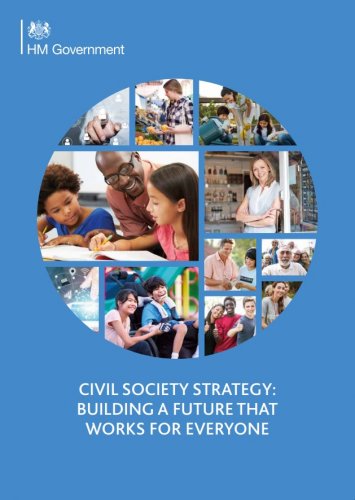The Civil Society Strategy sets out how the government will work to support and to strengthen civil society, without compromising its independence. Civil society refers to all individuals and organisations, when undertaking activities with the primary purpose of delivering social value, independent of state control. The government wants to build a partnership with charities and social enterprises, with volunteers, community groups and faith groups, with public service mutuals, socially responsible businesses and investors, and with the institutions which bring sports, arts, heritage, and culture to our communities.
A strong partnership of government, business, finance, and communities will help society rise to the enormous opportunities of our times. Civil society can help us make good on the promise of the 21st century: a more connected society, in which everyone can play their part.
Civil society can also help us tackle a range of burning injustices and entrenched social challenges, such as poverty, obesity, mental ill-health, youth disengagement, reoffending, homelessness, isolation, and loneliness, and the challenges of community integration.
Download the Civil Society Strategy
Across our society individuals and organisations, including traditional charities, social enterprises, mutuals, and mission-led businesses, are designing effective responses to social challenges. Together with public services and mainstream businesses, they are creating ‘social value’: enriched lives for individuals and social justice in all its forms.
The role of government – and the purpose at the heart of this Strategy – is to act as the convenor of the emerging coalition of people and organisations which, together, have the answers to the challenges of our times. This means leading the debate about the future social model our country needs, coordinating investment, tracking data on what works, and most of all, ensuring people themselves are at the heart of the system we are building together.
Contents
Ministerial Foreword
Executive Summary
Introduction
The purpose of the Strategy
The foundations of social value
How government plans to work
Next steps
Ministerial statement: responsible business
About the Strategy
Developing the Strategy
Engagement
What we heard
Scope of the Strategy
Defining civil society
Measuring success
The document
Chapter 1. PEOPLE: enabling a lifetime of contribution
Introduction
Mission 1: a connected, resourceful society
Loneliness and social connections
Civil society and disaster response
Ministerial statement: policing and civil society
Case study: Grenfell voluntary, community and social enterprise organisation funding approach
Mission 2: people in charge
Active, mobilised citizens
Case study: Community Organisers – building relationships across diverse communities
Government and public sector open to citizen input
Mission 3: opportunities for young people
Local youth services
Habits of social responsibility
Helping the most disadvantaged young people
Social responsibility in and out of school
Building on our offer for young people
Young people and national policy design
Case study: National Citizen Service – individual experience, Rais Aslam
Case study: Team London Young Ambassadors – young people improving their schools and communities
Ministerial statement: crime and civil society
Chapter 2. PLACES: empowerment and investment for local communities
Introduction
Mission 4: empowerment
Onward devolution
Participatory democracy
Community assets
Case study: a collaborative approach to commissioning and community participation
Case study: Suffolk Libraries
Mission 5: investment
Strategic spending
New models of finance
Supporting local sports, arts and culture
Ministerial statement: communities and civil society
Case studies: Greater Grimsby Town Deal Proposal, Greater Manchester Combined Authority
and West Midlands Combined Authority
Chapter 3. THE SOCIAL SECTOR: supporting charities and social enterprises
Introduction
Mission 6: the voice of civil society
The rules on campaigning
Hearing from civil society
Ministerial statement: the voice of civil society
Mission 7: funding and financing the social sector
Diversifying funding and finance
Philanthropy
Tax and Regulation
Case study: Big Lottery Fund
Mission 8: leadership, support and regulation
Leadership
Local support system
Charity regulation, transparency and safeguarding
Case studies: civil society and family support
Mission 9: a social sector confident with digital
Digital
Case study: Centre for Acceleration of Social Technology (CAST) – helping people use digital for social good
Ministerial statement: education and civil society
Chapter 4. THE PRIVATE SECTOR: promoting business, finance and tech for good
Introduction
Mission 10: responsible business
Supporting responsible businesses
Supporting Socially and Environmentally Purposeful Businesses
Updating corporate governance
Partnerships with business on social challenges
Promoting visibility and transparency
Sustainable Development Goals
Case study: the Inclusive Economy Partnership – using the power of partnerships to create positive social change
Mission 11: finance for good
Social impact investment
The government’s response to the Corley Review
Community shares
Financial inclusion
Mission 12: the role of technology
Tech for good
Ministerial statement: health and civil society
Chapter 5. THE PUBLIC SECTOR: ensuring collaborative commissioning
Introduction
Mission 13: a framework for collaborative commissioning
Supporting civil society from Whitehall
Citizen Commissioners
The role of local government
Case study: government, NHS and voluntary, community and social enterprise partnership working to enhance health and care
Mission 14: funding the future of public services
Alternative commissioning models
Grants 2.0
Flexible contracting
Case study: public service mutual – PossAbilities
Mission 15: commissioning for social value
Strengthening the Social Value Act
Ministerial statement: refugees and civil society
Annex A. Engagement Exercise: demographic information
Endnotes
Source: Government of the United Kingdom
Format
Source





